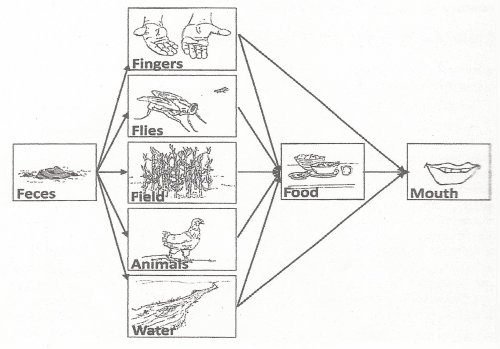Water Supply Contamination Originates From Multiple Sources and Occurs For Multiple Reasons
Water supply contamination is complex and community water systems are subject to multiple means of contamination.
Any behavior, custom, or process which brings pathogens found in human feces, into contact with the mouth, can result in water supply contamination and be a vehicle for transmitting disease.
This might sound strange, at first, but in places where adequate sanitation and hygiene are not practiced or available, people become exposed to pathogens found in human feces.
Poor practices present open pathways, from human feces, to animals, to flies and insects, to food, to hands; all of these can bring pathogens from feces to mouth. So transmission of pathogens can be accomplished through:
Lack of adequate sanitation
Unwashed food
Dirty hands
Unclean water transport vessels
Domesticated animals
Flies and other insects

Source: Lifewater International
The number of people living without clean water is staggering. According to the progress report of the WHO/UNICEF Millennium Development Goals, the number of people without an improved drinking water source has decreased from 1.1 billion to 884 million since the 1990’s.
Sub-Saharan Africa holds one-third of these people using unimproved water sources and living with water supply contamination. Worldwide, 8 out of 10 people who do not have improved sources of drinking water live in rural areas.
The number of people living without adequate sanitation is even greater! Although there has been some (but not enough) progress made in development of drinking water sources, improved sanitation facilities remain at unacceptably low levels. 2.5 billion people (38 percent of the world’s population) remain without improved sanitation facilities.
Again, the majority of these people live in sub-Saharan Africa as well as Southern Asia. 7 out of 10 of these people live in rural areas. 1.2 billion people still practice open defecation, the riskiest sanitation practice of all.What does “improved” drinking water and sanitation mean?

Improved drinking water is defined as a drinking water source that, by nature of its construction and design, is likely to protect the water source from outside contamination, in particular, from fecal matter.
Improved sanitation facilities are defined as those that hygienically separate human excreta from human contact. However, sanitation facilities are not considered improved when shared with other households, or open for public use.
Preventing water supply contamination requires a multi-faceted solution that is complicated by many social and cultural concerns.
Household water handling practices, improved sanitation facilities and practices, and proper hygiene, all work together to improve water quality and reduce the risk of disease transmission; to eliminate potable water contamination and death and disease caused by contaminants and water-borne pathogens.
Organizations that have been successful in bringing about real, lasting, transformational development have almost universally adopted the WASH concept. That is, Water, Sanitation, and Hygiene. Read more about this under “The Solution”.
Return to "The Problem" from "Water Supply Contamination"
Return to "Home"








